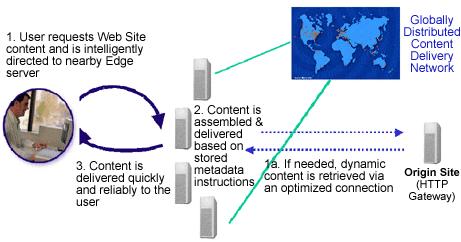Akamai is the largest content hosting company in the world. Their customers include some of the world's biggest websites like Yahoo!, Google, Microsoft, Apple and Reuters. No wonder, Akamai handles around 20% of the Internet Traffic with 18,000 servers spread across 70 countries.
With this huge network of machines spread across the globe, Akamai speeds the delivery of static Web content by caching it closer to end users. So if someone is visiting CNN website from New York City, the webpages will be served from Akamai servers located in or around NYC.

By funneling content requests across its 18,000 servers in real time, Akamai can effectively guarantee that a site won't crash because of overload.
Caching traditional webpages included handling of static HTML and associated web-graphics but with the advent of Web 2.0, web caching has a whole new meaning. With technologies like AJAX or Adobe Flex/Flash, client computers do not make repeated request to webservers because the logic is downloaded to the local computer itself.
If this sounds a bit too geek, try deleting a message in GMail - The Inbox view immediately opens without reloading the GMail website. That's dynamic caching.
But with Akamai customers adopting Web 2.0 technologies in a big way, Akamai have introduced a new content pre-fetching service to accelerate Web 2.0 delivery. Akamai edge servers pre-populate caches based on requests the browser is going to make.
Another service, dynamic content processing, enables some of the application logic to be processed at the edge of the network, rather than going back to an application server.
The final new service in the suite, Content Targeting, uses Akamai's 18,000 servers to build a map to geographic locations to zero in on where a request is originating.
Trivia: microsoft.com or yahoo.com are actually hosted on microsoft.akadns.net and yahoo.akadns.net respectively. So if the Akamai DNS server goes down, there's a high probability that you not be able to access your favorite websites.
Related: Net Usage Index for News - Chart web traffic in real time
Download Akamai Podcast: Tom Leighton discusses the growth of the Internet and the role Web applications will play.
With this huge network of machines spread across the globe, Akamai speeds the delivery of static Web content by caching it closer to end users. So if someone is visiting CNN website from New York City, the webpages will be served from Akamai servers located in or around NYC.

By funneling content requests across its 18,000 servers in real time, Akamai can effectively guarantee that a site won't crash because of overload.
Caching traditional webpages included handling of static HTML and associated web-graphics but with the advent of Web 2.0, web caching has a whole new meaning. With technologies like AJAX or Adobe Flex/Flash, client computers do not make repeated request to webservers because the logic is downloaded to the local computer itself.
If this sounds a bit too geek, try deleting a message in GMail - The Inbox view immediately opens without reloading the GMail website. That's dynamic caching.
But with Akamai customers adopting Web 2.0 technologies in a big way, Akamai have introduced a new content pre-fetching service to accelerate Web 2.0 delivery. Akamai edge servers pre-populate caches based on requests the browser is going to make.
Another service, dynamic content processing, enables some of the application logic to be processed at the edge of the network, rather than going back to an application server.
The final new service in the suite, Content Targeting, uses Akamai's 18,000 servers to build a map to geographic locations to zero in on where a request is originating.
Trivia: microsoft.com or yahoo.com are actually hosted on microsoft.akadns.net and yahoo.akadns.net respectively. So if the Akamai DNS server goes down, there's a high probability that you not be able to access your favorite websites.
Related: Net Usage Index for News - Chart web traffic in real time
Download Akamai Podcast: Tom Leighton discusses the growth of the Internet and the role Web applications will play.